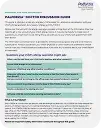The patient images are AI generated and are not real patients treated with PALFORZIA.
Individual results will vary with each patient.


Caregiver Brochure

Doctor
Discussion
Guide
Hosts Montel and Olga from The Balancing Act sit down with Benton and Pattie, parents of a young child, Ollie, living with peanut allergy, to share their family’s story. Joined by board-certified allergy specialist, Dr. Sriaroon, the discussion explores the impact of peanut allergy and how PALFORZIA may offer an option to help reduce the risk of severe allergic reactions due to accidental exposure.
These are real caregivers of real patients who are taking or have taken PALFORZIA and have been compensated for their time. Healthcare professionals featured are real physicians who treat or have treated patients with PALFORZIA and have been compensated for their time.
This is not a complete list of resources, and patients should consult their allergy specialist with any questions or for personalized guidance.

an organization in service of helping people with asthma and allergies, their families, and their communities.

is dedicated to saving lives and reducing the burden of food allergies through support, advocacy, education, and research.

focuses on outreach, education, advocacy, and research for people with asthma and allergies.

provides education, patient advocacy and support for individuals and families managing food allergies.

organization offers a network of support and promotes food allergy research and awareness.
Selecting any of these links will take you to a site that is not owned or controlled by Stallergenes Greer. Stallergenes Greer makes no representation as to the accuracy of the information contained on sites we do not own or control. Stallergenes Greer does not recommend and does not endorse the content on any third-party websites. Your use of third-party websites is at your own risk and subject to the terms and conditions of use for such sites.
The following includes information to discuss with an allergy specialist and is not intended to provide medical advice. They may not be the only questions you have. Always talk to an allergy specialist regarding questions related to PALFORZIA, treatment, and allergic reactions.
What is PALFORZIA?
PALFORZIA is a prescription medicine derived from peanuts. It is a treatment for people who are allergic to peanuts. PALFORZIA can help reduce the severity of allergic reactions, including anaphylaxis, that may occur with accidental exposure to peanut.1 PALFORZIA may be started in patients ages 1 through 17 years old with a confirmed diagnosis of peanut allergy.1
If your child turns 18 years of age while on PALFORZIA treatment, your child should continue taking PALFORZIA unless otherwise instructed by your child’s allergy specialist.1
PALFORZIA is intended to gradually decrease your child’s sensitivity to small amounts of peanuts that may be hidden in foods.1
PALFORZIA is a medication that must be taken daily to maintain the treatment effect.1
PALFORZIA is only intended to treat children with peanut allergy—it is not effective against other food allergies your child may have.1
PALFORZIA does NOT treat allergic reactions and should not be given during an allergic reaction.1
Your child must maintain a strict peanut-free diet while taking PALFORZIA.1
How does PALFORZIA work?
PALFORZIA is intended to gradually decrease your child’s sensitivity to peanuts, which may be hidden in foods, over time through oral immunotherapy (OIT). PALFORZIA can help reduce the severity of allergic reactions, including anaphylaxis, that may occur with accidental exposure to peanut.1,2
What is PALFORZIA REMS?
PALFORZIA is only available through a restricted program called the PALFORZIA Risk Evaluation and Mitigation Strategy (REMS) Program. The PALFORZIA REMS Program is a FDA-required drug safety program that manages the risk of anaphylaxis associated with prescription medicines, such as PALFORZIA, to ensure potential benefits outweigh the risks.
The goal of the program is to help mitigate the possibility of anaphylaxis associated with PALFORZIA.
Before your child can receive PALFORZIA, you must:1
(See details on dosing & starting treatment below)
PALFORZIA treatment cannot be started without the completion of the Patient REMS Enrollment form. Your child’s doctor will help you complete this form if they have decided to prescribe PALFORZIA for your child.
Talk to your child’s allergy specialist for more information about the PALFORZIA REMS program and the enrollment process.1
What is the treatment process?
There are three different phases of dosing with PALFORZIA: Initial Dose Escalation, Up-Dosing, and Maintenance Dosing.1
Initial Dose Escalation:1
The first set of doses (Initial Dose Escalation or IDE) of PALFORZIA will be administered on a single day in your child’s allergy specialist’s office.
The Initial Dose Escalation is about a 4-hour appointment. Your child’s doctor will observe your child after each dose of the Initial Dose Escalation for 20–30 minutes. For the last dose of the Initial Dose Escalation, the doctor will observe your child for at least 60 minutes.
If your child does not manage the Initial Dose Escalation, your child’s doctor may choose to not continue your child’s treatment with PALFORZIA.
Up-Dosing:1
If your child manages the Initial Dose Escalation phase, you and your child will return to your child’s allergy specialist’s office ideally the next day but at maximum, within 4 days of the IDE appointment to begin the Up-Dosing phase. There are 11 different dose levels of Up-Dosing. Toddlers aged 1 through 3 years start with PALFORZIA 1 mg (Level 0) and finish with PALFORZIA 300 mg (Level 11). Children and teens aged 4 through 17 years start with PALFORZIA 3 mg (Level 1) and finish with PALFORZIA 300 mg (Level 11).
The first dose of each Up-Dosing level is given in your child’s allergy specialist’s office. If your child manages the first dose of a new dose level, your child’s allergy specialist will have you continue to give your child that dose level every day at home over the next 2 weeks. PALFORZIA should be taken at approximately the same time each day with a meal.
During Up-Dosing, you and your child will return to your child’s allergy specialist’s office approximately every two weeks to be assessed for a new Up-Dosing level.
The treatment may be adapted to your child’s unique needs during Up-Dosing at the discretion of your child’s allergy specialist. For example, your child’s allergy specialist may modify the dosing amount and/or schedule during Up-Dosing if your child experiences an allergic reaction, needs to travel, or has an illness.
It is important to follow the Medical Information Guide provided with your child’s prescription and the instructions specified by your child’s doctor.
Maintenance Dosing:1
If your child manages all dose levels of the Up-Dosing phase, your child’s allergy specialist will move your child onto the Maintenance phase of dosing, which is a 300 mg dose of PALFORZIA everyday as Maintenance therapy at home.
It is important to continue taking PALFORZIA as Maintenance therapy in order to maintain the treatment effect.*
Your child’s allergy specialist will tell you if your child can take other medicines with PALFORZIA, such as other allergy treatments, medicines for your child’s stomach, or medicines for any other conditions that your child may have.
At the Maintenance phase, your child will likely have fewer PALFORZIA-related appointments with your child’s allergy specialist.
It is important to talk with your child’s allergy specialist regarding their unique treatment goals moving forward.
*PALFORZIA was studied for a minimum of at least 6 months of Maintenance treatment.
Is PALFORZIA an injection?
PALFORZIA is an oral powder that is mixed with refrigerated or room-temperature semi-solid foods such as applesauce, yogurt, or pudding. PALFORZIA is not an injectable medication.1
What is the most important information I should know about PALFORZIA?
PALFORZIA can cause severe allergic reactions, called anaphylaxis, that may be life-threatening.1
Stop PALFORZIA and get emergency medical treatment right away if your child has any of the following symptoms after taking PALFORZIA:1
For home administration of PALFORZIA, your child’s allergy specialist will prescribe epinephrine, a medicine you must administer if your child is having a severe allergic reaction after taking PALFORZIA. Your child’s allergy specialist will train and instruct on the proper use of epinephrine.1
Who should not use PALFORZIA?
Your child should NOT take PALFORZIA if:1
What should I tell my child’s allergy specialist before using PALFORZIA?
Tell your child’s allergy specialist if your child is not feeling well prior to starting treatment with PALFORZIA. Your child’s allergy specialist may decide to delay treatment until your child is feeling better. Also tell your child’s allergy specialist about any medical conditions your child has. You should tell your child’s allergy specialist if your child is taking or has recently taken any other medicines, including medicines obtained without a prescription and herbal supplements. Keep a list of them and show it to your child’s allergy specialist and pharmacist each time your child gets a new supply of PALFORZIA.1
Tell your child’s allergy specialist if your child is pregnant, planning to become pregnant, or breastfeeding.1
Your child’s allergy specialist may decide that PALFORZIA is not the best treatment if:1
Can my child take PALFORZIA with other medications they are taking?
Your child’s allergy specialist will tell you if your child can take other medicines with PALFORZIA, such as other allergy treatments, medicines for your child’s stomach, or medicines for any other conditions that your child has.1
Your child’s allergy specialist may decide that PALFORZIA is not the best treatment if:1
Tell your allergy specialist about any medical conditions your child has. Also tell your child’s allergy specialist if your child is taking or has recently taken any other medicines, including medicines obtained without a prescription and herbal supplements. Keep a list of them and show it to your child’s allergy specialist and pharmacist each time your child gets a new supply of PALFORZIA.1
What are the possible side effects of PALFORZIA?
The most commonly reported side effects in toddlers aged 1 through 3 years were cough, sneezing, runny nose, stuffy nose, throat irritation, wheezing, stomach pain, vomiting, diarrhea, itching or burning in the mouth, throat and mouth pain, hives, rash, itchy skin, and/or rash around the mouth.1
The most commonly reported side effects in children and teens aged 4 through 17 years were stomach pain, vomiting, feeling sick, itching or burning in the mouth, throat irritation, cough, runny nose, sneezing, throat tightness, wheezing, shortness of breath, itchy skin, hives, and/or itchy ears.1
PALFORZIA can cause severe allergic reactions, including anaphylaxis, that may be life-threatening. Symptoms of allergic reactions to PALFORZIA can include:1
PALFORZIA can cause stomach or gut symptoms including inflammation of the esophagus (called eosinophilic esophagitis). Symptoms of eosinophilic esophagitis can include:1
Contact your child’s doctor if any of these allergic reactions occur. If your child has a severe allergic reaction during PALFORZIA treatment, they should stop taking PALFORZIA, administer epinephrine, as prescribed by your child’s doctor, immediately and get emergency medical help.
For additional information on the possible side effects of PALFORZIA, talk with your doctor or pharmacist. You may report side effects to the U.S. Food and Drug Administration (FDA) at 1-800-FDA-1088 or www.fda.gov/medwatch
How am I supposed to prepare a dose of PALFORZIA for my child?
Prepare and take PALFORZIA as instructed by your child’s allergy specialist. PALFORZIA is provided as either capsules or sachets.1
Open the daily dose of PALFORZIA capsule(s) or sachet and empty the full dose of PALFORZIA oral powder onto refrigerated or room-temperature semi-solid foods like applesauce, yogurt, or pudding. Do not use liquid (e.g., milk, water, juice) to prepare. Mix well.1
Use just enough food so that your child can consume the entire dose in a few spoonfuls. Your child should consume the dose right away after it has been mixed.1
You and your child should wash your hands immediately after handling PALFORZIA capsules or sachets.1
Your child should not swallow the capsules, or breathe in the powder.1
PALFORZIA should be taken at approximately the same time each day with a meal.1
Your child should not take more than one dose of PALFORZIA in a single day.1
Your child should not take PALFORZIA at home on the days that your child visits the doctor for PALFORZIA Up-Dosing as your child’s doctor may give your child PALFORZIA on these days as part of the appointment.1
What happens if my child misses a dose?
If your child misses taking a dose of PALFORZIA, contact your child’s allergy specialist. Do not take additional doses on the same day to make up for missed doses.1
Can my child continue normal activities after taking PALFORZIA?
It is advised that your child should not exercise or have a hot bath or shower within three hours of taking PALFORZIA, as this may cause an increased potential for an allergic reaction.1
If your child has been exercising or has taken a hot bath or shower and feels hot, or your child is sweating and your child’s heart is beating fast, do not let your child take PALFORZIA until your child has cooled down and has a normal heartbeat.1
Certain conditions may increase the likelihood of an allergic reaction. These include:1
How should I store PALFORZIA?
PALFORZIA can be kept at room temperature, 2° to 25°C (36° to 77°F).1
Keep PALFORZIA out of the reach of children.1
Throw away any unused PALFORZIA after the expiration date.1
PALFORZIA should be kept inside the blister packs.
How much does PALFORZIA treatment cost?
Out-of-pocket costs may vary. You must speak to your pharmacist or insurance provider to determine your out-of-pocket cost. Eligible, commercially insured patients may qualify for the PALFORZIA Pathway™ Co-Pay Savings Program and may pay as little as $20 per month for PALFORZIA, with a maximum benefit of $6,200 per calendar year. Offer not valid for patients enrolled in Medicare, Medicaid, or other federal or state healthcare programs. Please see Program Terms, Conditions, and Eligibility Criteria. After the annual maximum benefit is reached, the patient or legal guardian will be responsible for all PALFORZIA out-of-pocket costs.
The co-pay assistance from the program may be applied only to PALFORZIA drug out-of-pocket costs, including plan deductibles, co-payments, or co-insurance; co-pay assistance from the program cannot be applied toward physician office visits or other medical expenses.
Our PALFORZIA Pathway customer representatives can assist eligible patients in enrolling in the PALFORZIA Pathway program that’s right for them.
If PALFORZIA has been prescribed, ask your child’s allergy specialist how to get started in our program or call 1-844-PALFORZ for PALFORZIA Pathway Patient Support.
What is a specialty pharmacy?
In order for your child to receive PALFORZIA in a timely manner, the prescription must be filled by Walgreens Specialty Pharmacies. These specialty pharmacies have expertise in dispensing medications like PALFORZIA and are different from your usual pharmacy. After receiving the prescription, Walgreens Specialty Pharmacies ships the drug to your preferred location. Your child’s doctor will initiate each prescription request to the specialty pharmacy directly.
Note: Your child, their allergy specialist, and the allergy specialist’s practice must all be enrolled in the PALFORZIA REMS Program before treatment can begin.
Where do I get PALFORZIA?
PALFORZIA is only available through a restricted program called the PALFORZIA Risk Evaluation and Mitigation Strategy (REMS) Program, accessible here.
Once you and your child’s allergy specialist have made the decision to start PALFORZIA, your child’s allergy specialist will write your child a prescription, which can either be shipped directly to your home or to your child’s allergy specialist’s office by the specialty pharmacy.
PALFORZIA prescriptions are filled by a specialty pharmacy, which has expertise in dispensing medications like PALFORZIA and is different from your usual pharmacy. PALFORZIA prescriptions are dispensed by Walgreens Specialty Pharmacies. For questions about a specific prescription, talk to your doctor or for questions for the pharmacist call Walgreens Specialty Pharmacies: 1-800-445-3674.
You should always speak with your child’s doctor about any questions you
may have to determine if PALFORZIA might be right for your child.
We are also here to help you. Contact us using the button below to learn more.

References:
Enter your zip code to find a PALFORZIA REMS-certified provider near you.
Models for illustrative purposes only.


PALFORZIA can cause severe allergic reactions called anaphylaxis that may be life-threatening and can occur at any time during PALFORZIA therapy.
PALFORZIA is a treatment for people who are allergic to peanuts. PALFORZIA can help reduce the severity of allergic reactions, including anaphylaxis, that may occur with accidental exposure to peanut. PALFORZIA may be started in patients aged 1 through 17 years old. If you turn 18 years of age while on PALFORZIA treatment you should continue taking PALFORZIA unless otherwise instructed by your doctor. PALFORZIA does NOT treat allergic reactions and should not be given during an allergic reaction, including anaphylaxis. You must maintain a strict peanut-free diet while taking PALFORZIA.
Stop taking PALFORZIA and get emergency medical treatment right away if you have any of the following symptoms after taking PALFORZIA:
Because of the risk of severe allergic reactions, PALFORZIA is only available through a restricted program called the PALFORZIA Risk Evaluation and Mitigation Strategy (REMS) Program. PALFORZIA is a prescription only medication. Talk to your healthcare provider for more information about the PALFORZIA REMS program and how to enroll.
You should NOT take PALFORZIA if you have uncontrolled asthma, or if you ever had eosinophilic esophagitis (EoE) or other eosinophilic gastrointestinal disease.
Tell your doctor if you are not feeling well prior to starting treatment with PALFORZIA. Your doctor may decide to delay treatment until you are feeling better. Also tell your doctor about any medical conditions you have and if you are taking or have recently taken any other medicines, including medicines obtained without a prescription and herbal supplements.
Your doctor may decide that PALFORZIA is not the best treatment if:
What are the possible side effects of PALFORZIA?
The most commonly reported side effects of PALFORZIA in ages 1 through 3 years were: cough, sneezing, runny nose, nasal congestion, throat irritation, wheezing, stomach pain, vomiting, diarrhea, itchy mouth, pain in the throat, hives, rash, itchy skin, and/or inflammation of the skin around the mouth.
The most commonly reported side effects of PALFORZIA in ages 4 through 17 years were: stomach pain, vomiting, feeling sick, itching or burning in the mouth, throat irritation, cough, runny nose, sneezing, throat tightness, wheezing, shortness of breath, itchy skin, hives, and/or itchy ears.
PALFORZIA can cause severe allergic reactions called anaphylaxis that may be life-threatening.
PALFORZIA can cause stomach or gut symptoms including inflammation of the esophagus (called eosinophilic esophagitis). Symptoms of eosinophilic esophagitis can include:
For additional information on PALFORZIA and/or the possible side effects, talk with your doctor or pharmacist.
Please see full Prescribing Information, including Boxed WARNING and Medication Guide.
You are encouraged to report negative side effects of prescription drugs to the FDA. Visit www.fda.gov/medwatch or call 1-800-FDA-1088.